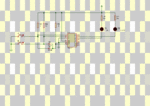milan.rajik
Banned

I have to control a bi color LED from two signals lines. The CC or CA pin of led will be connected to power GND or +ve rail through a 330E resistor. When one button is pressed (signal goes low) the green led has to turn ON and when another button goes low the red LED has to turn ON. Only one button can be low at a time. Both high or both low is invalid. Once a button is pressed and signal goes low then that led color has to remain ON till another signal goes low. Which logic device can I use for this ?
Last edited:









